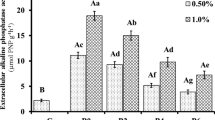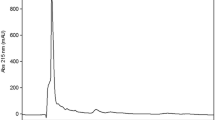Abstract
This paper presents the results of studies on the activity of extra-cellular enzymes in soil-willow vegetation filter soil which is used in the post-treatment of household sewage in an onsite wastewater treatment system located in central Poland. Wastewater is discharged from the detached house by gravity into the onsite wastewater treatment system. It flows through a connecting pipe into a single-chamber septic tank and is directed by the connecting pipe to a control well to be further channelled in the soil-willow filter by means of a subsurface leaching system. Soil samples for the studies were collected from two depths of 5 cm and 1 m from three plots: close to the wastewater inflow, at mid-length of the plot and close to its terminal part. Soil samples were collected from May to October 2009. The activity of the extra-cellular enzymes was assayed by the fluorometric method using 4-methylumbelliferyl and 7-amido-4-methylcoumarin substrate. The ranking of potential activity of the assayed enzymes was the same at 5 cm and 1 m soil depths, i.e. esterase > phosphmomoesterase > leucine-aminopeptidase > β-glucosidase > α-glucosidase. The highest values of enzymatic activity were recorded in the surface layer of the soil at the wastewater inflow and decreased with increasing distance from that point.
Access this article
We’re sorry, something doesn't seem to be working properly.
Please try refreshing the page. If that doesn't work, please contact support so we can address the problem.



Similar content being viewed by others
References
Aon MA, Colaneri AC (2001) Temporal and spatial evolution of enzymatic activities and physico-chemical properties in an agricultural soil. Appl Soil Ecol 18:255–270
Acosta-Martínez V, Cruz L, Sotomayor-Ramírez D, Pèrez-Alegría L (2007) Enzyme activities as affected by soil properties and land use in a tropical watershed. Appl Soil Ecol 35:35–45
Acosta-Martínez V, Zobeck TM, Gill TE, Kennedy AC (2003) Enzyme activities and microbial community structure of agricultural semiarid soils. Biol Fertil Soils 38:216–227
Bednarek R, Dziadowiec H, Pokojska U, Prusinkiewicz Z (2004) Ecology and soil science research. Polish Scientific Publishers, Warsaw
Boschker HTS, Cappenberg TE (1994) A sensitive method using 4 methylumbelliferyl-b-cellobiose as a substrate to measure (1,4)-b-glucanase activity in sediments. Appl Environ Microbiol 60:3592–3596
Brix H, Arias CA, Del Bubba M (2001) Media selection for sustainable phosphorus removal in subsurface flow constructed wetlands. Water Sci Technol 44(11–12):47–54
Brzezinska M, Tiwari SC, Stepniewska Z, Nosalewicz M, Bennicelli RP, Samborska A (2006) Variation of enzyme activities, CO2 evolution and redox potential in an Eutric Histosol irrigated with wastewater and tap water. Biol Fertil Soils 43:131–135
Caldwell BA (2005) Enzyme activities as a component of soil biodiversity: a review. Pedobiologia 49:637–644
Chmielowska AM (2002) Hydrophyte treatment systems. Environmental engineering, vol 7. Academy of Mining and Metallurgy, Krakow
Duarte B, Reboreda R, Caçador I (2008) Seasonal variation of extracellular enzymatic activity (EEA) and its influence on metal speciation in a polluted salt marsh. Chemosphere 73:1056–1063
Freeman CG, Liska SE, Jones Lock MA (1995) The use of fluorogenic substrates for measuring enzyme activity in peatlands. Plant Soil 175:147–152
Furczak J, Joniec J (2009) Microbial populations and activity of biochemical processes related to carbon and nitrogen transformations in podzolic soil under willow culture in fifth year from treatment with sewage sludge. Polish J Environ Stud 18(5):801–810
Heal OW, MacLean SF (1975) Comparative productivity in ecosystem-secondary productivity. In: van Dobben WH, Lowe-McConell RH (eds) Unifying concepts in ecology. Dr. W. Junk B.V. Publishers, The Hague, The Netherlands, pp 89–108
Hoppe HG (1983) Significance of exoenzymatic activities in the ecology of brackish water: measurements by means of methylumbelliferyl substrates. Marine Ecol Prog Ser 11:299–308
Hoppe HG, Ulrich S (1999) Profiles of ectoenzymes in the mesopelagic zone. Aquatic Microb Ecol 19:139–148
Kadlec RH, Knight RL (1996) Treatment wetlands. Lewis Publishers, Boca Raton, FL, pp 236–240
Kang H, Freeman C, Lee D, Mitsch WJ (1998) Enzyme activities in constructed wetlands: implication for water quality amelioration. Hydrobiologia 368:231–235
Kannan K, Oblisami G (1990) Influence of paper mill effluent irrigation on soil enzyme activities. Soil Biol Biochem 22:923–926
Kivaisi AK (2001) The potential for constructed wetlands for wastewater treatment and reuse in developing countries: a review. Ecol Eng 16:545–560
Klose S, Moore JM, Tabatabai MA (1999) Arylsulfatase activity of microbial biomass in soils as affected by cropping systems. Biol Fertil Soils 29:46–54
Klose S, Tabatabai MA (2002) Response of glycosidases in soils to chloroform fumigation. Biol Fertil Soils 35:262–269
Kocik A, Truchan M, Rozen A (2007) Application of willows (Salix viminalis) and earthworms (Eisenia fetida) in sewage sludge treatment. Eur J Soil Biol 43:327–331
Kong L, Wang YB, Zhao LN, Chen ZH (2009) Enzyme and root activities in surface-flow constructed wetlands. Chemosphere 76:601–608
Lalke-Porczyk E, Swiontek Brzezinska M, Donderski W (2009) Influence of the root system of the Common Osier (Salix viminalis L.) on abundance of heterotrophic bacteria in the willow sewage treatment system. Curr Microbiol 58:571–577
Lammirato C, Miltner A, Wick LY, Kästner M (2010) Hydrolysis of cellobiose by β-glucosidase in the presence of soil minerals—interactions at solideliquid interfaces and effects on enzyme activity levels. Soil Biol Biochem 42:2203–2210
Martinez J, Smith DC, Steward GF, Azam F (1996) Variability in ectohygrolytic enzyme activities of pelagic marine bacteria and its significance for substrate processing in the sea. Aquat Microb Ecol 10:223–230
Marx MC, Wood M, Jarvis SC (2001) A microplate fluorometric assay for the study enzyme diversity in soils. Soil Biol Biochem 33:1633–1640
Marxsen J, Witzel KP (1990) Measurement of exoenzymatic activity in stream bed sediments using methylumbelliferyl-substrates. Arch Hydrobiol Beih 34:21–28
Mitsch WJ, Gosselink JG (1993) Wetlands, 2nd edn. Van Nostrand Reinhold, New York, pp 10–18
Nadgórska-Socha A, Ciepał R, Pomierny S (2003) Activity of selected enzymes in soil with different levels of heavy metals load. In: The soil in the environment. Instystut of Geography and Spatial Management, Kracow
Niemi RM, Vepsäläinen M (2005) Stability of the fluorogenic enzyme substrate and pH optima of enzyme activities in different Finnish soils. J Microbiol Methods 60:195–205
Obarska-Pempkowiak H (2002) Constructed wetland. Gdansk University of Technology Publishing House, Poland
Quiquampoix H, Burns RG (2007) Interactions between proteins and soil mineral surfaces: environmental and health consequences. Elements 3:401–406
Reboreda R, Cacador I (2008) Enzymatic activity in the rhizosphere of Spartina maritima: potential contribution for phytoremediation of metals. Mar Environ Res 65:77–84
Reddy KR, D’Angelo EM (1994) Soil processes regulating water quality in wetlands. In: Mitch WM (ed) Global wetlands-old world and new. Elsevier, New York, pp 309–324
Rejmánková E, Sirová D (2007) Wetland macrophyte decomposition under different nutrient conditions: relationships between decomposition rate, enzyme activities and microbial biomass. Soil Biol Biochem 39:526–538
Russell S (2005) The importance of studies of enzymes in soil. Acta Agrophysica, Dissertations and monographs
Schimel JP, Bennett J (2004) Nitrogen mineralization: challenges of a changing paradigm. Ecology 85:591–602
Shackle VJ, Freeman C, Reynolds B (2000) Carbon supply and the regulation of enzyme activity in constructed wetlands. Soil Biol Biochem 32:1935–1940
Solano ML, Soriano P, Ciria MP (2003) Constructed wetlands as a sustainable solution for wastewater treatment in small villages. Biosyst Eng 87:109–111
Stottmeister U, Wießner A, Kuschk P, Kappelmeyer U, Kästner M, Bederski O, Müller RA, Moormann H (2003) Effects of plants and microorganisms in constructed wetlands for wastewater treatment. Biotechnol Adv 22:93–117
Stroczyńska-Sikorska M, Kłapeć T, Cholewa A (1995) Methodological Guidelines (microbiological-parasitological) to assess the health of the soil. Institute of Rural Medicine, Lublin
Tabatabai MA, Dick WA (2002) Enzymes in soil. Research and developments in measuring activities. In: Burns RG, Dick RP (eds) Enzymes in the environment activity, ecology, and applications. Marcel Dekker, Inc, New York, pp 567–595
Vervaeke P, Luyssaert L, Mertens J, Meers E, Tack FMG, Lust N (2003) Phytoremediation prospects of willow stands on contaminated sediment: a field trial. Environ Pollut 126:275–282
Yan J, Pan G (2010) Effects of pulp wastewater irrigation on soil enzyme activities and respiration from a managed wetland. Soil Sed Contam 19:204–216
Author information
Authors and Affiliations
Corresponding author
Rights and permissions
About this article
Cite this article
Brzezinska, M.S., Lalke-Porczyk, E. & Kalwasińska, A. Extracellular Enzyme Activity in a Willow Sewage Treatment System. Curr Microbiol 65, 776–783 (2012). https://doi.org/10.1007/s00284-012-0230-4
Received:
Accepted:
Published:
Issue Date:
DOI: https://doi.org/10.1007/s00284-012-0230-4




